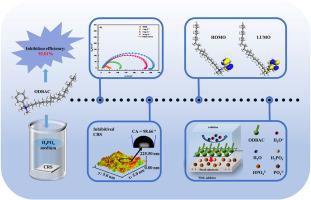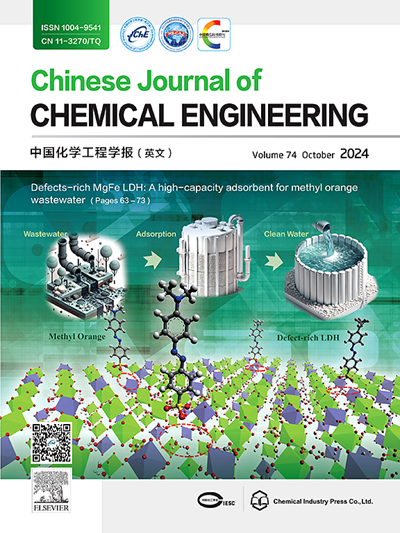磷酸介质中十八烷基二甲基苄基氯化铵在钢表面的吸附行为与抑制性能:实验与理论研究
IF 3.7
3区 工程技术
Q2 ENGINEERING, CHEMICAL
引用次数: 0
摘要
采用可生物降解的绿色有机化合物十八烷基二甲基苄基氯化铵(ODBAC)作为冷轧钢(CRS)在磷酸(H3PO4)中的高效缓蚀剂。通过实验和理论计算研究了ODBAC在CRS上的吸附和成膜机理。失重法表明,在浓度为10 mg·L−1时,ODBAC的抑制率可达92.01%。ODBAC在CRS表面的吸附符合Langmuir等温线模型,是一种以物理吸附为主的混合吸附。x射线光电子能谱(XPS)和接触角结果证实了ODBAC膜的存在,钢表面的疏水性得到了显著增强。电化学测试结果表明,该膜的形成主要抑制了阴极腐蚀反应,有效地增加了电荷传递电阻。量子化学计算发现ODBAC中的N18和苯环上的C24和C25是关键的活性吸附位点。分子动力学模拟结果表明,ODBAC可以将自由分数体积大幅降低至8%,并抑制腐蚀颗粒的扩散,即形成的ODBAC膜使腐蚀颗粒难以渗透,从而提高了CRS在H3PO4中的耐腐蚀性。本文章由计算机程序翻译,如有差异,请以英文原文为准。

Adsorption behavior and inhibition performance of octadecyl dimethyl benzyl ammonium chloride on steel surface in phosphoric acid medium: Experimental and theoretical investigations
A biodegradable and green organic compound octadecyl dimethyl benzyl amm-onium chloride (ODBAC) was used as an efficient inhibitor for cold rolled steel (CRS) in phosphoric acid (H3PO4). The mechanism of adsorption and film formation of ODBAC on CRS was studied through experimental and theoretical calculations. The weight loss method shows that the inhibition efficiency of ODBAC can reach 92.01% at a concentration of 10 mg·L−1. The adsorption of ODBAC on the CRS surface conforms to the Langmuir isotherm model, which is a mixed adsorption mainly based on physical adsorption. The X-ray photoelectron spectroscopy (XPS) and contact angle results confirmed the existence of the ODBAC film and steel surface's hydrophobicity has been significantly enhanced. Electrochemical test results reveal that the film's formation mainly inhibits the cathodic corrosion reaction and effectively increases the charge transfer resistance. Quantum chemical calculations have found that N18 in ODBAC and C24 and C25 on the benzene ring are the key active adsorption sites. Molecular dynamics simulation results indicate that ODBAC can sharply reduce the free fraction volume to 8% and inhibit the diffusion of corrosion particles, meaning that the formed ODBAC film makes it difficult for corrosion particles to penetrate, thus improving the corrosion resistance of CRS in H3PO4.
求助全文
通过发布文献求助,成功后即可免费获取论文全文。
去求助
来源期刊

Chinese Journal of Chemical Engineering
工程技术-工程:化工
CiteScore
6.60
自引率
5.30%
发文量
4309
审稿时长
31 days
期刊介绍:
The Chinese Journal of Chemical Engineering (Monthly, started in 1982) is the official journal of the Chemical Industry and Engineering Society of China and published by the Chemical Industry Press Co. Ltd. The aim of the journal is to develop the international exchange of scientific and technical information in the field of chemical engineering. It publishes original research papers that cover the major advancements and achievements in chemical engineering in China as well as some articles from overseas contributors.
The topics of journal include chemical engineering, chemical technology, biochemical engineering, energy and environmental engineering and other relevant fields. Papers are published on the basis of their relevance to theoretical research, practical application or potential uses in the industry as Research Papers, Communications, Reviews and Perspectives. Prominent domestic and overseas chemical experts and scholars have been invited to form an International Advisory Board and the Editorial Committee. It enjoys recognition among Chinese academia and industry as a reliable source of information of what is going on in chemical engineering research, both domestic and abroad.
 求助内容:
求助内容: 应助结果提醒方式:
应助结果提醒方式:


